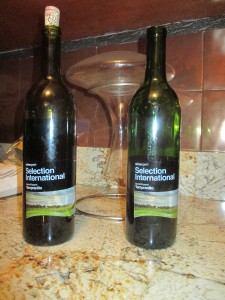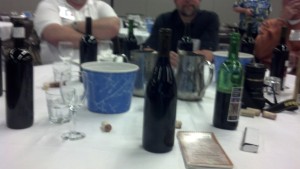Tempranillo, Part IV: Wine Faults and Me
It’s been about a year since I bottled my Tempranillo, and so I thought it was time to give it a try. This is a wine I had great hopes for: I had participated in a tasting at WineMaker magazine’s conference last year, and the wine had received reviews that ranged from the merely positive to almost glowing. And it had been in the bottle for only 35 days – hardly over bottle shock.
So you can imagine my surprise when, almost immediately after opening the bottle, I detected an odor – not an aroma, mind you, but an odor. I thought perhaps that it was just one of those things – a little, well, I don’t know what. I just thought it would pass.
It didn’t.
I poured the wine, swirled it vigorously, and sniffed. It stunk.
And then I swirled the glass much longer and even more vigorously, and sniffed again. It still stunk.
Well, I thought, perhaps it’s one of those wines with barnyard or some such aromas but wonderful tastes. I think there are such things. Well, actually, I have no idea. I was just hoping.
But if there are such things, they didn’t account for this bottle’s problems. It tasted just awful. I suppose that if I were a still a college student, more interested in the alcohol content than the aromas and taste of the wine, I could have choked it down. I’m sure I drank much worse in those days. (Remember Ripple? Boone’s Farm?)
But today? No, no way. I would say that in an even more emphatic way, but this is a family friendly blog and such language is not permitted.
I can’t begin to tell you how depressed I was beginning to feel. This was my prize wine, the star of all the wines I have made, and I had outrageously outsized expectations for it. And yet, the evidence was clear. It stunk.
That was especially bad news now, since I’m getting ready for our first grape harvest in a couple of months. If my very best effort with a kit wine had turned out so badly, how could I possibly expect to do well with fresh fruit, which is a much more complicated process.
I decided I would give the bottle another day, so I set it aside and opened a California Pinot Noir to drink instead.
The next night, I opened the Tempranillo again, more in fear than anticipation, and quickly realized my instincts were right. It still stunk. Probably as much as the first night, maybe more. Now I was really depressed.
But a day later, on the way into work, I suddenly realized that I recognized that bottle’s foul smell. TCA taint. The wine was corked. I was sure of it.
A corked bottle is one that has been tainted by 2,4,6-Trichloroanisole, or TCA for short. It’s usually described as smelling like a damp basement or wet socks left too long in the hamper. Over the years, I’ve read that something like one to five bottles out of every hundred suffer from TCA taint. I actually find that hard to believe, since I rarely encounter one. In fact, I have to say that the only reason I recognized this flaw as TCA taint is because I took a class last year on wine faults and had an opportunity to sniff and taste a corked wine.
Even so, I clearly wasn’t prepared to believe that a wine I had made and bottled could possibly be corked. The idea hadn’t even entered my head.

A tale of two bottles. They came out of the same tank, made in exactly the same way, but one was a joy to drink, and the other sucked!
But this evening, energized by this flash of insight, I pulled out another bottle of the same Tempranillo to taste. I have to say, I was a bit concerned – clearly, my bottling technique could use some work because there was at least an extra inch of air in the neck of the bottle. Well, that’s why I’m working with kits: trying to get all the mistakes out of my system.
Opening the new bottle, I was prepared for the worst. But after pulling the cork, I sniffed the wine from the bottle and was thrilled – no sign of TCA! I poured a half-glass, swirled, sniffed and was elated. The wine was definitely not corked. But was it good?
I tasted it, and wanted to shout. Yes, indeed, it was good. Soft tannins, big fruit, nice acidity. I’m guessing that Robert Parker won’t be including it in the next issue of the Wine Advocate, but whether it warrants a score of 92 or 82, it was good – a lovely, drinkable wine.
So, I’m somewhat more confident about my prospects as a winemaker. And, as a bonus, I have another two cases of good wine that I don’t have to pour down the drain.
A final word. I think everyone who loves wine should feel comfortable returning a bottle and telling a waiter at a restaurant or the manager at a wine store that the wine is flawed. I’ve done this perhaps a half-dozen times in my life. And at Total Wines, for example, they never bat an eye. They take the bottle and invite me to get another. And I suppose they would offer me a refund, but I’ve never asked. It seems more fair to get another bottle of the same wine.
And that’s the point. If you buy a wine, you should be prepared to deal with it. If you decide it’s not to your taste, ok, you won’t be buying it again. But you shouldn’t think you’re entitle to a refund because you like soft tannins and the wine you bought needs a couple of years in the cellar. Or because you bought a white that was aged in oak and you suddenly realize that you prefer whites aged in stainless.
But a genuine fault is different. If the wine is corked or oxidized, if it has severe Brettanomyces, then you should feel comfortable in sending in back. It’s not always an easy call. It took me two days to realize my wine was corked. And Brettanomyces? Well, that’s a touchy subject. A little can add some character, more than that can ruin the wine.
So, I guess the best advice I can offer is to trust your instincts, but be reasonable. And over time, if you taste enough wine, you’ll learn to recognize common wine faults. Which, thank God, are few and far between these days.
Category: All Posts, Jefferson, Wine, Winemaking




Great post and website. I’m enjoying reading it.